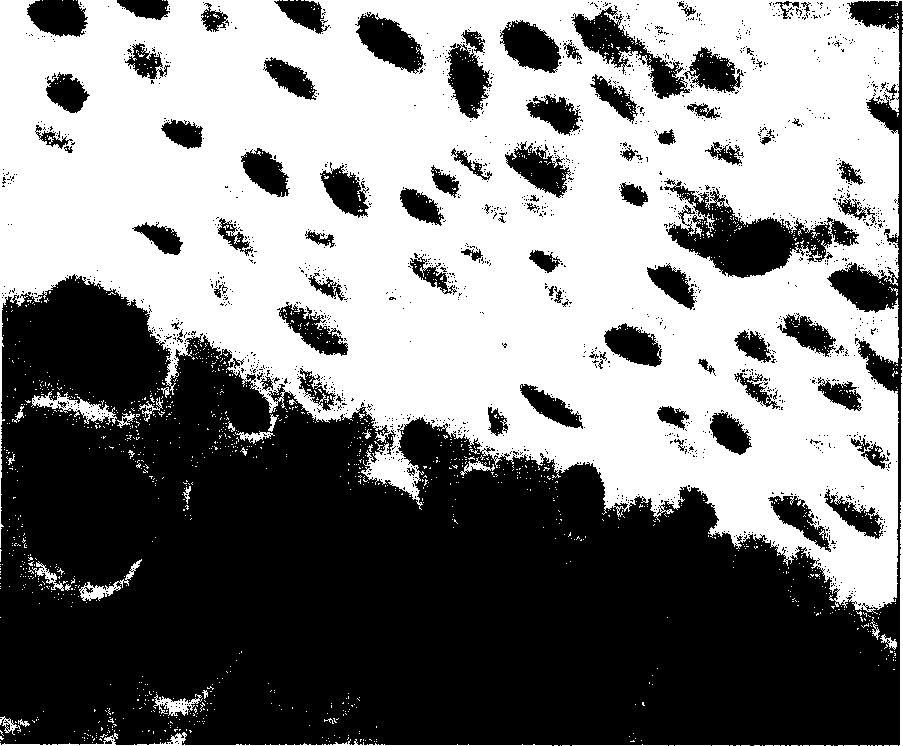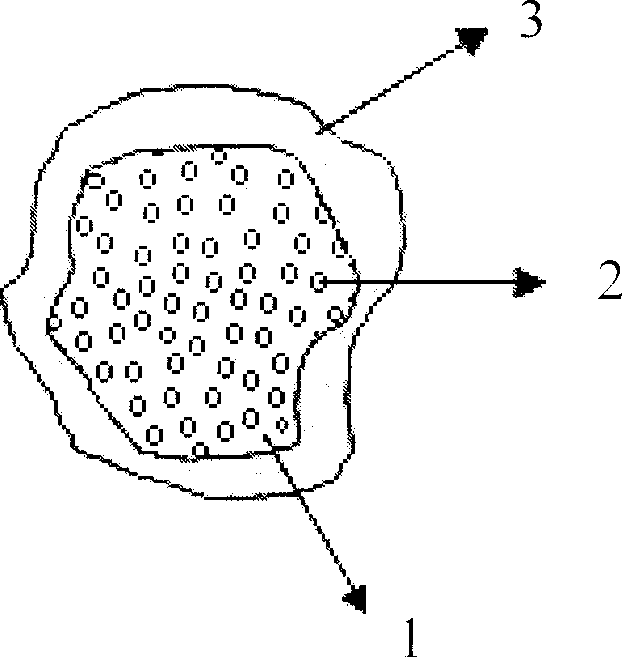Bone tissue rack of TiO2 reinforced polyhydroxyethyl methacrylate and its prepn process
A polyhydroxyethyl methacrylate and bone tissue technology, applied in the field of bone tissue scaffolds and their preparation, can solve problems such as adverse effects on cell activity, and achieve the effects of improving mechanical properties and enhancing strength
- Summary
- Abstract
- Description
- Claims
- Application Information
AI Technical Summary
Problems solved by technology
Method used
Image
Examples
specific Embodiment approach 1
[0015] Specific implementation mode one: as figure 1 and 2 As shown, the embodiment of TiO 2 Nanoparticle-reinforced macroporous pHEMA bone tissue scaffold made of polyhydroxyethylmethacrylate 1, TiO 2 Composed of nanoparticles 2 and hydroxyapatite 3, TiO is added to polyhydroxyethylmethacrylate 1 2 The nanoparticles 2 form a scaffold material, and a layer 3 of hydroxyapatite is deposited on the inner and outer surfaces of the scaffold material. The polyhydroxyethyl methacrylate described in this embodiment has a three-dimensional interconnected macroporous structure, the pore diameter ranges from 100 to 1000 μm, and the porosity is above 70%; TiO 2 The size of the nanoparticles is 10-50nm, and the mass percentage added is 1-20%; the thickness of the hydroxyapatite layer is 1-10 μm.
specific Embodiment approach 2
[0016] Specific embodiment two: this embodiment prepares TiO according to the following steps 2 Nanoparticle-enhanced macroporous pHEMA bone tissue scaffold: a. Three-dimensional porous poly(hydroxyethyl methacrylate) was prepared by photocrosslinking salt leaching method, and TiO was added 2 nanoparticles, to obtain TiO 2 Nanoparticle-reinforced three-dimensional interconnected macroporous poly(hydroxyethyl methacrylate) bone tissue scaffold material; b, TiO 2 The nanoparticle-reinforced three-dimensional interconnected macroporous poly(hydroxyethyl methacrylate) bone tissue scaffold material was immersed in hydroxyapatite hydrochloric acid solution containing urea, the pH value of the solution was 1-5, and the solution was gradually heated from room temperature to 90-100 ℃, control the heating rate to 0.1~0.5℃ / min, without stirring; c, then carry out mineralization treatment under the condition of 95~100℃, and obtain TiO with a thickness of 1~10μm hydroxyapatite layer depos...
specific Embodiment approach 3
[0018] Specific embodiment three: this embodiment prepares TiO according to the following steps 2 Nanoparticle-enhanced macroporous pHEMA bone tissue scaffold: a. Poly(hydroxyethyl methacrylate) with macroporous structure was prepared by sol-gel method, and then TiO was added 2 Nanoparticles, TiO2 prepared by melt-shaping particulate leaching 2 Nanoparticle-reinforced three-dimensional interconnected macroporous poly(hydroxyethyl methacrylate) bone tissue scaffold material; b, TiO 2 The nanoparticle-reinforced three-dimensional interconnected macroporous poly(hydroxyethyl methacrylate) bone tissue scaffold material was immersed in hydroxyapatite hydrochloric acid solution containing urea, the pH value of the solution was 1-5, and the solution was gradually heated from room temperature to 90-100 ℃, control the heating rate to 0.1~0.5℃ / min, without stirring; c, then carry out mineralization treatment under the condition of 95~100℃, and obtain TiO with a thickness of 1~10μm hydr...
PUM
| Property | Measurement | Unit |
|---|---|---|
| Aperture range | aaaaa | aaaaa |
| Size | aaaaa | aaaaa |
| Thickness | aaaaa | aaaaa |
Abstract
Description
Claims
Application Information
 Login to View More
Login to View More - R&D
- Intellectual Property
- Life Sciences
- Materials
- Tech Scout
- Unparalleled Data Quality
- Higher Quality Content
- 60% Fewer Hallucinations
Browse by: Latest US Patents, China's latest patents, Technical Efficacy Thesaurus, Application Domain, Technology Topic, Popular Technical Reports.
© 2025 PatSnap. All rights reserved.Legal|Privacy policy|Modern Slavery Act Transparency Statement|Sitemap|About US| Contact US: help@patsnap.com


